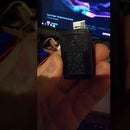Introduction: Visuino Pro Macchina Interface OBDII Get Started LED Blink
Film pokazuje najprostszy z programów którym rozpocząłem testowanie interfejsu MACCHINA M2 OBDII
Translate : A video showing the simplest example from the MACCHINA M2 OBDII interface testing
Step 1:
Postaram
się pokazywać kolejno w odcinkach to co zrobiłem korzystając z interfejsu OBDII firmy MACCHINA.CC Każdy odcinek będzie zawierał krótki film oraz prosta instrukcję jak wykonać taki sam projekt. Do uruchomienia interfejsu używam oprogramowania VISUINO które można pobrać ze strony www.visuino.com Jest także wersja profesjonalna tego oprogramowania która pozwala na używanie programu z innymi protokołami komunikacyjnymi jak MODUS. Do pobrania na google plus visuino. W tym odcinku z racji tego, że firma produkująca interfejs wysłała mi go do testów oraz analizy, korzystając z ich pomocy postaram się dodawać jak najwięcej szczegółów, żeby rozpowszechnić ich produkt, który jest w moim mniemaniu wykonany profesjonalnie. Wszelkie dane instalacji płyty MACCHINA.CC można znaleźć na ich stronie www.visuino.com Znajdziemy tam grono instrukcji a także proste filmy instruktażowe. W tym przypadku rozpoczynając pracę musimy zainstalować płytę macchina jako osobną płytę arduino o nazwie macchina M2. Proces instalacji jest opisany na ich stronie i można z niego skorzystać nawet jeśli ktoś nigdy wcześniej nie miał styczności z arduino. Oczywiście potrzebne nam będzie arduino ide – najnowsza wersja oraz visuino pro. Po pobraniu programów instalacja jest na tyle prosta że nie trzeba jej opisywać, wymaga kilku kliknięć. Po dodaniu płytki macchina M2 w menadżerze płytek, możesz przystąpić do otwarcia projektu który został przeze mnie stworzony w visuino.
Translate:
I'll try
to be shown sequentially in what I did using the MACCHINA.CC OBDII interface. Each episode will contain a short film and a simple instruction on how to do the same project. To run the interface I use VISUINO software that can be downloaded from www.visuino.com. There is also a professional version of this software that allows you to use the program with other communication protocols like MODUS. Downloadable on google plus visuino. In this episode due to the fact that the company that produced the interface sent it to me for testing and analysis, using their help I will try to add as much detail as possible to distribute their product, which in my opinion is professionally made. All MACCHINA.CC disc installation data can be found on their website www.visuino.com. We will find there a group of instructions as well as simple instructional videos. In this case, when we start work, we have to install the macchina plate as a separate arduino board called macchina M2. The installation process is described on their website and can be used even if someone has never had contact with arduino before. Of course, we will need arduino ide - the latest version and visuino pro. After downloading the programs, the installation is so simple that you do not have to describe it, it requires a few clicks. After adding the M2 macchina plate in the tile manager, you can proceed to the opening of the project that was created by me in visuino.
Step 2:
Po otwarciu projektu na ekranie pokaże się prosty licznik do 8 napędzany generatorem 5Hz Jest to nieodzowny element do poruszania licznikiem. Kolejnym komponentem połączonym szeregowo jest IntegerMultiSource1 Jest to komponent łączący wejścia sygnałowe do komparatorów, które wychodzi z licznika. Na komparatory jest podawany sygnał cyfrowy z licznika i wędruje kolejno do komparatorów których zadaniem jest zapalanie i gaszenie diod LED umieszczonych na interfejsie MACCHINA M2 Każdy z nich ma przypisaną wartość liczbową która odpowiada kolejnej wartości z licznika. Dzięki temu kiedy wartość licznika wynosi 1 powoduje to pojawienie się stanu wysokiego na pinie wyjściowym komparatora który jest ustawiony na porównywanie wartości wejściowych z wartością w nim przypisaną. W tym przypadku wartość dla komparatora CompareValue1 wynosi 1 Więc kiedy wartość liczbowa licznika wynosi 1 powoduje to zapalenie się diody LED na interfejsie. I tak każdy kolejny komparator zawiera w sobie cyfrę 2 kolejny 3 kolejny 4 kolejny 5. Ich schemat podłączenia można znaleźć na obrazku w kolejnym kroku.
Translate: After opening the project, a simple counter up to 8 driven by a 5Hz generator will appear on the screen. This is an indispensable element for moving the meter. The next component connected in series is IntegerMultiSource1. It is a component that connects the signal inputs to the comparators that comes out of the meter. The digital signal from the meter is sent to the comparators and goes to the comparators in order to ignite and extinguish the LEDs located on the MACCHINA M2 interface. Each of them has a numerical value assigned which corresponds to the next value from the counter. Thanks to this, when the value of the counter is 1, it causes the appearance of a high state on the output pin of the comparator which is set to compare the input values with the value assigned in it. In this case, the value for the comparator CompareValue1 is 1 So when the numeric value of the counter is 1, the LED on the interface lights up. And so each subsequent comparator contains the number 2 of the next 3 following 4 next 5. Their wiring diagram can be found in the picture in the next step.
Attachments
Step 3:
Na foto powyżej znajdziemy pinout interfejsu oraz jego rozmieszczenie diod LED w samej płycie głównej. Jest to standardowa aplikacja podłączenia diod LED do procesora jaki został użyty w tym projekcie . na stronie WWW.MACHINA.CC Możesz przeczytać że jest to SAM Atmel SAM3X8E ARM Cortex-M3 W tym projekcie diody LED zostały podłączone pod zasilanie 3V3 dlatego też użyłem na wyjściach komparatorów inwerterów do odwrócenia sygnałów. Inaczej diody paliły by się cały czas a tylko ta której numer jest wyzwalany gasłaby. W tym wypadku dzieje się tak jak na filmie na stronie 1 czyli każda kolejno się zapala i gaśnie. Piszcie w komentarzach czy uruchomienie się udało.
Translate: On the photo above, we find the interface pinout and its arrangement of LEDs in the motherboard itself. This is a standard application for connecting LEDs to the processor that was used in this project. on WWW.MACHINA.CC You can read that it is SAM Atmel SAM3X8E ARM Cortex-M3 In this project, the LEDs were connected to 3V3 power, which is why I used the inverter comparators to reverse the signals. Otherwise, the diodes would be burning all the time and only the one whose number is triggered would go out. In this case, it's like the movie on page 1, so each turns on and goes off. Write in comments if the launch was successful.












